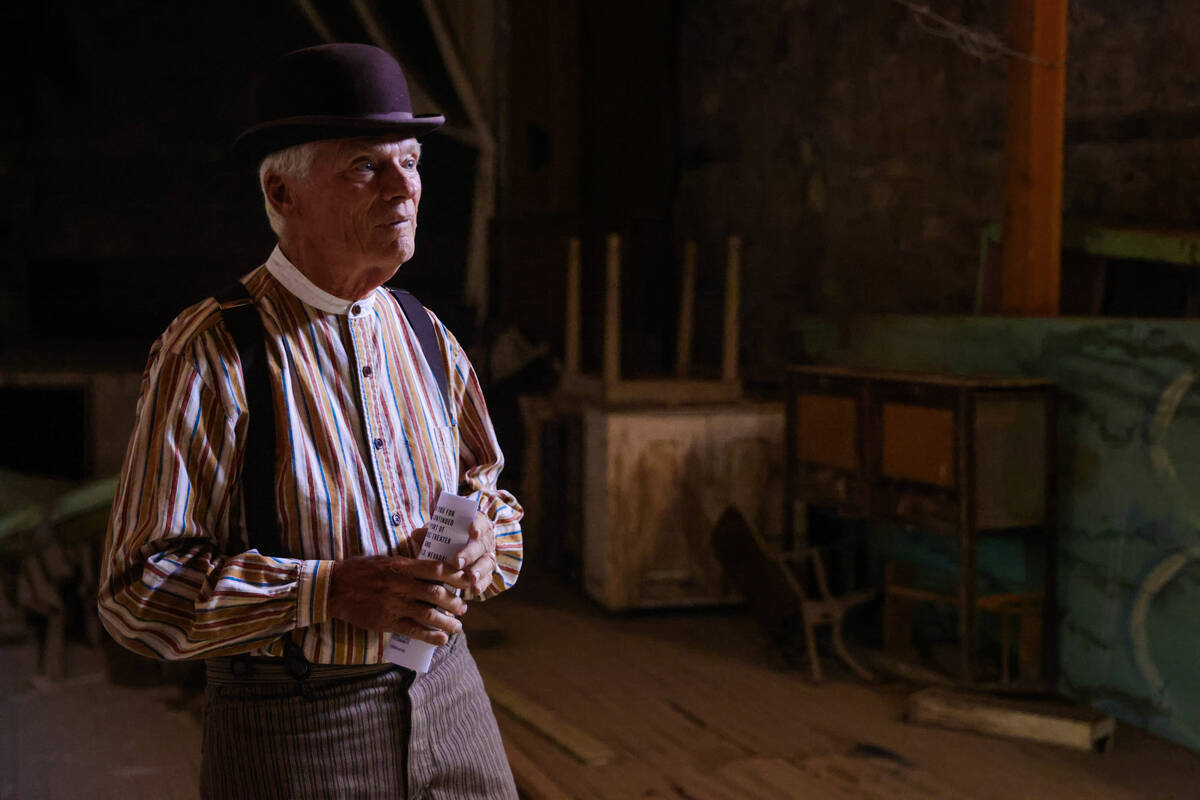Goldfield historians hope to keep town alive through tourism, preservation

GOLDFIELD — As John Ekman walked through Goldfield during its annual Goldfield Days celebration, he recalled a time when the town’s population was 100 times larger and gold was king.
Goldfield, located 183 miles north of Las Vegas, made a name for itself in the early 1900s as Nevada’s biggest town and prospecting hub — a place where people came to take all the gold they could find until nearly none of the precious metal was left.
But today, the Goldfield Historical Society president talks of a town resource that, if he can help it, won’t be depleted: its rich history.
“History is a renewable resource,” Ekman said, standing inside the century-old Lyric Theater. “Things are constantly getting old, and becoming more and more interesting.”
While mining remains a significant economic driver for Esmeralda County, Ekman said he believes the thing that will keep the tiny town alive into the future is “heritage tourism” — a way for the town to capitalize on people’s fascination with the Old West with tours of restored historic buildings that help illustrate what the town looked like in its hayday.
“The economic engine of the state is tourism,” he said. “Mining is important, but tourism is what makes this state run. History is becoming even more important, and it’s becoming a larger part of the tourism industry.”
Bringing Goldfield into the digital age
One of the ways town history buffs are hoping to draw people to Goldfield is by first connecting with them online.
Ted Faye, a documentary filmmaker and author of several books about Goldfield and Death Valley, is working with the Historical Society to make productions about the town’s lesser-known stories to draw younger generations into Goldfield, where the median age of town residents is 58.5 years old — roughly 20 years older than the state’s, according to U.S. Census data.
One of Faye’s current projects is making a film about the 1906 Gans-Nelson fight in Goldfield — the longest fight in boxing history, where Joe Gans, America’s first Black sports champion, went 42 rounds against Oscar “Battling” Nelson, capturing the fascination of the national press and drawing roughly 15,000 fans to the town.
“The whole idea is to try to speak to a younger generation, (and) say, ‘Hey, we’ve got great stories here, and they’re relevant stories, too,’ — especially to folks in Nevada,” Faye said.
Social media could prove another key to drawing in younger visitors, according to Ronnie Raffaniello, who runs the Instagram account @Goldfieldrevival and website goldfieldrevival.com, which showcases Goldfield history and entices tourists to attend the town’s special events with the hope that it will keep the town alive.
“My whole goal is to try to get especially the younger generation interested, because once (the older) generation is gone, the people who really know about the town are gone with it,” she said.
And while Goldfield’s online presence is ever important, Raffaniello and Faye said getting people there will all be for naught if nothing from its history is preserved.
Raffaniello and her family are working with the Historical Society to revive the Lyric Theater, purchased by her great-grandmother, and transform it into a community space for plays and special movie screenings.
Faye said he believes these kinds of restoration projects are more important than ever for the town’s future.
“You want to give people a feel of … what it would be like to see it when it was in its glory days — not just to have a shell of the building,” Faye said. “This kind of preservation really has an important role, and to try to get younger people to be interested in it is important for the future.
“Otherwise, we’re just going to be left with a digital world, and at some point, people are gonna want to step out and see something real.”
Saving Goldfield High School
One of the principal restoration projects in the works is on Goldfield High School, constructed in 1907 and one of the six multistory buildings left in town.
After the school’s south wall fell three floors down to its foundation in 2005, Ekman said that, while town residents started making bets on which wall would fall next, he started working to secure grants to save it.
Over the last 19 years, grants and donations have allowed the Historical Society to repair the building’s south and east walls, restore its front stairs and, in May this year, finally complete its roof restoration.
Inside the school, Ekman points out other needed improvements: windows that need glass, uneven wooden floors soiled in pigeon waste that need to be cleaned and a collection of donated antique pianos that will someday need to be moved.
But he celebrates the wins, too. The roof doesn’t leak anymore — except for the skylight that still needs repairs — and he boasts about the south wall that he says would stand even if the town was hit by an earthquake.
He said he hopes the building can one day serve as a community hub and interpretive center to share Esmeralda County’s history.
Still, Ekman noted, there is much more work to be done.
“It all takes time.”
Contact Taylor Lane at tlane@reviewjournal.com.